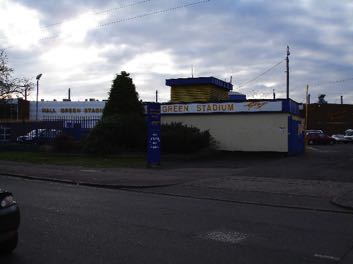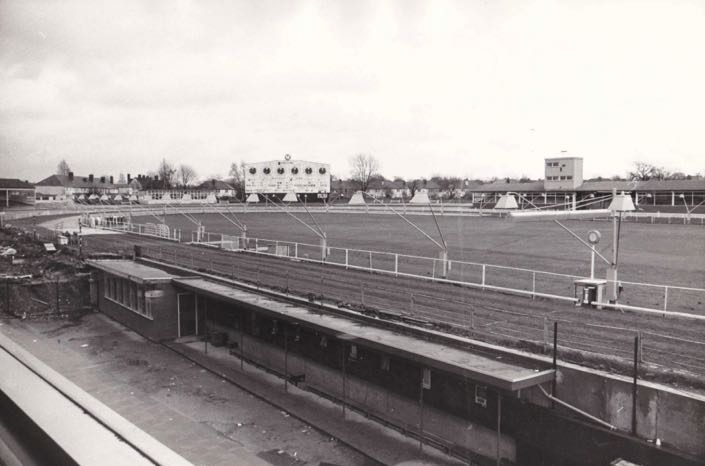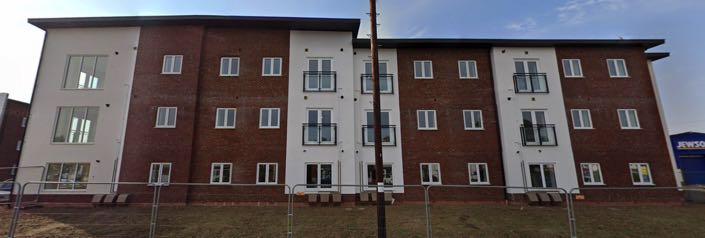- Address: 151 York Rd, Hall Green, Birmingham B28 8LQ
- Status: Permanently Closed

Located in the suburb of Birmingham after which it was named, Hall Green Stadium opened its doors for the first time back in 1927. A 412-metre long oval track, the venue that surrounded it was big enough to welcome between 2,500 and 3,000 people. As well as an a la carte restaurant, there were some fast food outlets for those that preferred their greyhound racing experience to be a little more down-to-earth. There was even a hotel located on bends three and four, some of the rooms of which had a view of the track.
It is fair to say that Hall Green was something of a cater-to-all type venue, considering the fact that there was a snooker hall along the back straight that offered 21 full-size snooker tables for players to use. The writing was on the wall for the dog track in 2014 when the National Asset Management Agency sold the venue, retaining a lease agreement for it. It eventually shutdown permanently following the evening’s racing on the 29th of July, 2017 with demolition of it getting underway in May of the following year.
Major Races & Events
During its time as one of the country’s leading greyhound racing venues, Hall Green played host to some big-name competitions. In 1993, for example, the British Breeders Forum Produce was switched from Wembley to Hall Green, and the Blue Riband followed suit six years later.
As the millennium came around, a decision was taken to inaugurate some new races, with the Gymcrack being started at Hall Green in 2000 and the Prestige coming along three years after that. The sacrifice was that the track’s oldest race, the Midland Flat, was discontinued as a result. Here is a list of some of the races that took place at Hall Green, as well as the years that they were raced at the Midlands track:
- Blue Riband – 1999 to 2012
- Golden Jacket – 1985
- Grand National – 1985 to 1999
- Gymcrack – 2000 to 2010
- Midland Flat – 1946 to 2006
- Prestige – 2003 to 2017
- Produce Stakes – 1993 to 2008
In addition, the prestigious Television Trophy was hosted at Hall Green three times. It took place at the venue for the first time in 1979 before returning nine years later. The third occasion that the Television Trophy was run there was in 1997, two years before the Blue Riband arrived.
In the News
As you might imagine, closed greyhound stadiums don’t appear in the news as much as those that are still open. Even so, there remains a fascination with former sporting venues as people enjoy reminiscing about their time there. As a result, Hall Green Stadium was written about in April 2021 when a journalist for Birmingham Live wrote a piece about what state the development of new homes at the location was in. There are 109 affordable homes built on the site, with 101 other properties also available for purchase there.
About Hall Green Stadium

In 1927, greyhound tracks began popping up all around the country. As a result, the Greyhound Racing Association decided to buy the location known as the Olympia Sports Ground in the area of Hall Green on the outskirts of Birmingham in order to open a venue in the city. It opened its doors for the first time on the 24th of April in 1927, being the first greyhound track in Birmingham at the time. Around 20,000 people turned up to see what all the fuss was about, witnessing Lock Latham win the first ever race run at the stadium.
The people who turned up at Hall Green that night also witnessed a dog called Bonzo winning his race, which might not have been all that significant if not for what happened later in the year. Bonzo went to White City Stadium and won the inaugural race of the Champion Hurdle, an event that would later become known as the Grand National. Though there is no link between Bonzo’s win and the race later arriving at Hall Green, it is obviously a curious quirk of history that the two were linked from the very first running.
The Stadium’s Formative Years
During the early years of Hall Green’s existence as a greyhound racing venue, the track was 440-yards in circumference and considered to be a decent sized circuit. It had long straights and fairly easy turns, allowing for quick races. Most of the races were handicap offerings, whilst the dogs chased an Inside Sumner hare around the track. The main distances on offer were 500 yards and 700 yards, whilst the facilities included a main stand that also doubled-up as the Hall Green Sports Club and the Enclosure Club.
People could pay a small annual subscription in order to gain admittance to the clubs, with a restaurant service being introduced after a few years. As well as greyhound racing, speedway races took place at Hall Green between 1928 and 1938, playing host to the Birmingham Bulldogs. In the wake of the Second World War, the track introduced the Midland Flat Championship, whilst the central area was the home of the Hall Green Amateurs football team between 1951 and 1965, ensuring maximum use of the space.
Renovations Take Place
In 1970, investment was poured into Hall Green in order to allow it to become one of the biggest provincial tracks in the United Kingdom. The Greyhound Racing Association spent more than £750,000 adding a four-tier restaurant to the club house, as well as the erection of an electronic tote board. The kennels were demolished, with the track instead moving to a contract trainer system. It became an all-sand venue in 1981, replacing the former grass straights, whilst an Outside McKee Scott hare was introduced.
Undersoil heating was also introduced in 1981, then, six years later, a large snooker hall was built. This came as part of a series of improvements that cost around £400,000. Another £1 million was spent in 1989, this time allowing for the extension of the restaurant and the building of The Lodge hotel. This also present an opportunity to improve the track, so a new surface was laid down during the same period of developments. It proved to be the last time that major upgrades were carried out to Hall Green before its closure.
Records at Hall Green
By the time that the track closed, it had seen records set over a number of distances. Here are some of the records that will stand for the rest of time:
| Distance | Record Time | Date Set |
|---|---|---|
| 258 Metres | 15.12 Seconds | 18th April 2012 |
| 259 Metres | 15.46 Seconds | 30th November 1985 |
| 474 Metres | 28.20 Seconds | 19th November 1994 |
| 480 Metres | 28.02 Seconds | 13th April 2010 |
| 606 Metres | 38.78 Seconds | 27th March 1982 |
| 645 Metres | 39.01 Seconds | 22nd September 2000 |
| 663 Metres | 41.37 Seconds | 9th April 1988 |
| 670 Metres | 40.44 Seconds | February 1995 |
| 683 Metres | 41.29 Seconds | 4th October 1991 |
| 815 Metres | 52.50 Seconds | 27th April 1988 |
| 820 Metres | 51.71 Seconds | 24th June 1993 |
| 892 Metres | 55.24 Seconds | 27th March 2007 |
| 480 Metre Hurdles | 28.52 Seconds* | 8th April 1992 |
| 645 Metre Hurdles | 40.70 Seconds | 25th February 2003 |
*Record set during the final of the Grand National
The Closing of the Track: What Happened to Hall Green Stadium?

In 2014, a decision was taken by the National Asset Management Agency, which was the parent company of the Greyhound Racing Association, to sell a couple of stadiums in order to bring in some revenue. Belle Vue in Manchester was one, with Hall Green being another. In both instances, the NAMA retained a lease agreement, Hall Green’s coming from Euro Property Investments that had paid £3 million for the venue. Unsurprisingly, Euro Property Investments Limited soon made an application to build houses at the location of the track.
This application was initially declined by the council in June of 2016, but this was appealed against and overturned. As a result, a move to demolish the stadium was approved, leading to the Chief Executive of the track, Clive Feltham, to reveal in June of 2017 that Hall Green would close at the end of July. The final night of racing took place on the 29th of the month, with demolition work getting under way in May of the following year. This was to make way for housing, which is now open and boasting occupants.